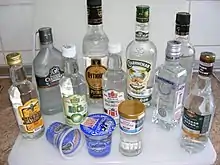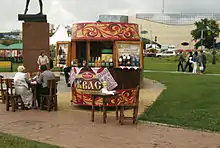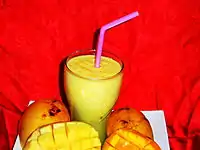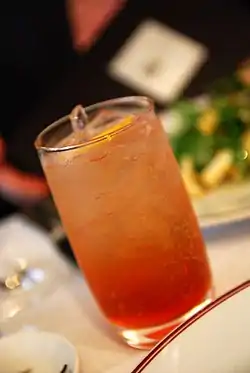Portal:Drink
The Drink Portal
A portal dedicated to all beverages
Introduction
A drink or beverage is a liquid intended for human consumption. In addition to their basic function of satisfying thirst, drinks play important roles in human culture. Common types of drinks include plain drinking water, milk, juice, smoothies and soft drinks. Traditionally warm beverages include coffee, tea, and hot chocolate. Caffeinated drinks that contain the stimulant caffeine have a long history.
In addition, alcoholic drinks such as wine, beer, and liquor, which contain the drug ethanol, have been part of human culture for more than 8,000 years. Non-alcoholic drinks often signify drinks that would normally contain alcohol, such as beer, wine and cocktails, but are made with a sufficiently low concentration of alcohol by volume. The category includes drinks that have undergone an alcohol removal process such as non-alcoholic beers and de-alcoholized wines. (Full article...)
Selected article -

Fresh liquid cider is extracted from the whole apple itself, including the apple core, trimmings from apples, and oddly sized or shaped “imperfect” apples, or apple culls. Fresh cider is opaque due to fine apple particles in suspension and generally tangier than commercially cooked and filtered apple juice, but this depends somewhat on the variety of apples used. Cider is sometimes pasteurized or exposed to UV light to kill bacteria and extend its shelf life, but traditional raw untreated cider is still common. Some companies have begun adding preservatives and boiling cider, so that it can be shelf stable and stored without refrigeration. In either form, apple cider is seasonally produced in autumn. It is traditionally served throughout autumn on Halloween, Thanksgiving, Christmas, and various New Year's Eve holidays, sometimes heated and mulled. (Full article...)
Did you know? -
- ... that the Buddha is said to have sat under a charoli tree at Bodh Gaya for seven days without eating, drinking, washing, excreting, or lying down?
- ... that Jewish-Russian Zinaida Vengerova, a pioneer in Russian decadence, allowed a circle of intellectuals to drink her blood in a ritual described as anti-Semitic?
- ... that an image of MacCarthy's Bar on the front cover of a book featured a staff member posing as a nun drinking a pint of Guinness and the surprise appearance of a dog?
- ... that Phil Elverum recorded Don't Wake Me Up nocturnally, while "drinking pots of black tea all night"?
- ... that tourists on holiday trips arranged by the Finland travel agency Keihäsmatkat were encouraged to drink alcoholic beverages, partly to avoid culture shock?
- ... that German minister Wolfgang Clement said that the secret to drinking a glass of beer in 1.5 seconds was to fold back the uvula?
General images -
Selected image -

Selected biography -
Selected quote -
| “ | Coffee should be black as hell, strong as death, and sweet as love. | ” |
| — Turkish proverb |
Selected ingredient -

Caramel color or caramel coloring is a water-soluble food coloring. It is made by heat treatment of carbohydrates (sugars), in general in the presence of acids, alkalis, or salts, in a process called caramelization. It is more fully oxidized than caramel candy, and has an odor of burnt sugar and a somewhat bitter taste. Its color ranges from pale yellow to amber to dark brown.
Caramel color is one of the oldest and most widely used food colorings for enhancing naturally occurring colors, correcting natural variations in color, and replacing color that is lost to light degradation during food processing and storage. The use of caramel color as a food additive in the brewing industry in the 19th century is the first recorded instance of it being manufactured and used on a wide scale. Today, caramel color is found in many commercially produced foods and beverages, including batters, beer, brown bread, buns, chocolate, cookies, cough drops, spirits and liquor such as brandy, rum, and whisky, chocolate-flavored confectionery and coatings, custards, decorations, fillings and toppings, potato chips, dessert mixes, doughnuts, fish and shellfish spreads, frozen desserts, fruit preserves, glucose tablets, gravy, ice cream, pickles, sauces and dressings, soft drinks (especially colas), sweets, vinegar, and more. Caramel color is widely approved for use in food globally but application and use level restrictions vary by country. (Full article...)
Topics
| General topics: | Bartending • Bottling • Drinking • Drinking water • Bottled water • Mineral water • Coffee • Energy drink • Juice • Tea • Milk • Plant milk • Pasteurization • Refrigeration • Steeping • Water purification |
| Alcoholic beverages: | Beer • Brandy • Brewing • Caffeinated alcoholic drinks • Cider • Cocktails • Distillation • Fermentation • Hard soda • Liquor • Liqueur • Malt drink • Mead • Proof • Rice Wine • Schnapps • Vodka • Whiskey • Wine |
| Soft Drinks: | Carbonation • Cola • Orange soft drink • Frozen carbonated drink • Root beer • Soda water • Lithia water • |
| Miscellaneous: | Drink industry • Lemonade • Limeade • Orange drink • Slush (beverage) |
List articles
More drink list articles
Subcategories
Related portals
WikiProjects
WikiProject Food & Drink is an association of Wikipedians with an interest in culinary-related subjects. They have come together to co-ordinate the development of food and drink articles here on Wikipedia as well as the many subjects related to food such as foodservice, catering and restaurants. If you wish to learn more about these subjects as well as get involved, please visit the project.
.svg.png.webp) WikiProject Beer – covers Wikipedia's coverage of beer and breweries and microbreweries
WikiProject Beer – covers Wikipedia's coverage of beer and breweries and microbreweries
![]() WikiProject Wine – aims to compile thorough and accurate information on different vineyards, wineries and varieties of wines, including but not limited to their qualities, origins, and uses.
WikiProject Wine – aims to compile thorough and accurate information on different vineyards, wineries and varieties of wines, including but not limited to their qualities, origins, and uses.
| Child projects: | Task forces: (All inactive) |
|
|
| Related projects: | |
| |
Things you can do
 |
Here are some tasks awaiting attention:
|
Associated Wikimedia
The following Wikimedia Foundation sister projects provide more on this subject:
-
 Commons
Commons
Free media repository -
 Wikibooks
Wikibooks
Free textbooks and manuals -
 Wikidata
Wikidata
Free knowledge base -
 Wikinews
Wikinews
Free-content news -
 Wikiquote
Wikiquote
Collection of quotations -
 Wikisource
Wikisource
Free-content library -
 Wikiversity
Wikiversity
Free learning tools -
 Wiktionary
Wiktionary
Dictionary and thesaurus
More portals
-
 List of all portalsList of all portals
List of all portalsList of all portals -
 The arts portal
The arts portal -
 Biography portal
Biography portal -
 Current events portal
Current events portal -
 Geography portal
Geography portal -
 History portal
History portal -
 Mathematics portal
Mathematics portal -
 Science portal
Science portal -
 Society portal
Society portal -
 Technology portal
Technology portal -
 Random portalRandom portal
Random portalRandom portal -
 WikiProject PortalsWikiProject Portals
WikiProject PortalsWikiProject Portals





.jpg.webp)





.jpg.webp)










.jpg.webp)











.jpg.webp)



.jpg.webp)






.JPG.webp)

